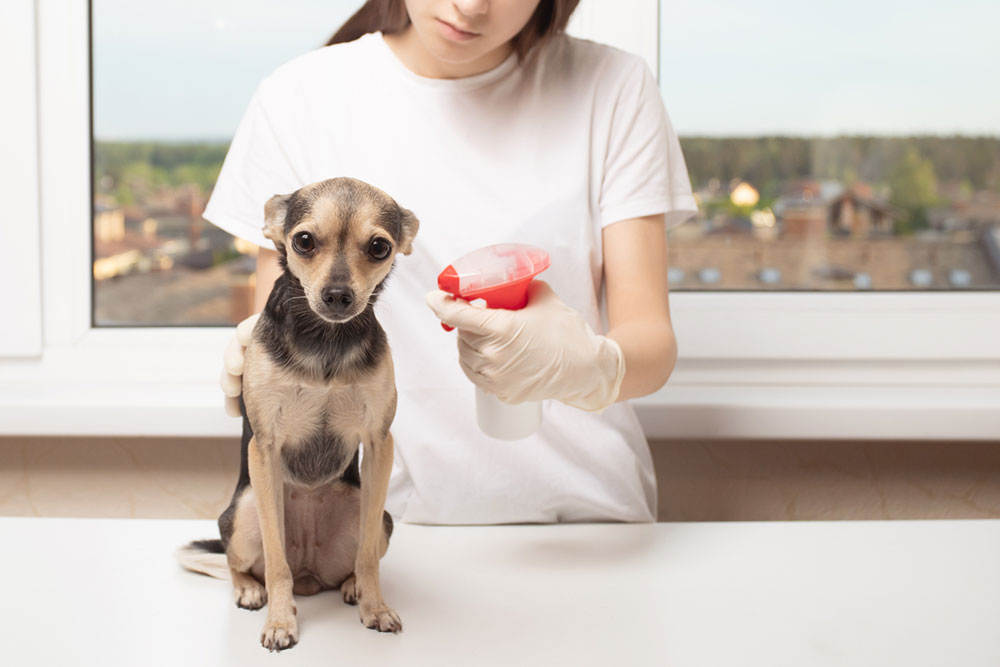7 kitchen ingredients to effectively fight fleas on dogs

Fleas are tiny, blood-sucking parasites that can have a significant impact on dogs’ well-being when they get transmitted to them. These insects can cause constant discomfort and even health problems in dogs, which can worsen if left untreated. While several treatments are available to fight fleas on dogs, some common kitchen ingredients can also effectively combat them. Here are some ways fleas infest pets and effective kitchen ingredients that can help with the problem.
How do fleas infest dogs?
Dogs can become flea-infested in a variety of ways. Here are some of them given below:
Contact with infested animals
Close proximity with other infested dogs, cats, or wildlife can allow fleas to jump from one host to another. Apart from that, visitors to the home may also lead to a flea infestation since the insects can hitch a ride on clothing or personal belongings of humans.
Infested environments
Fleas can be present in environments where infested animals have been. This can be indoors, like bedding, carpets, or furniture at poorly kept dog care centers, or outdoors, such as yards, parks, public spaces, or other travel places. So, dogs can pick up fleas from the ground, grass, or other surfaces.
Kitchen remedies to fight fleas on dogs
There are several kitchen ingredients that can help one fight fleas on one’s dog. Some of them include:
Apple cider vinegar
This versatile kitchen staple is a powerful tool against fleas. Mixing equal parts of vinegar and water in a spray bottle creates a natural flea repellent. Gently spray this solution onto the dog’s fur, focusing on the areas where fleas tend to congregate, such as around the neck, ears, paws, axillary areas, back, and tail. The acidic nature of vinegar makes the dog’s skin less hospitable to fleas, and the smell acts as a deterrent.
Baking soda
Sprinkling a generous amount of baking soda on the dog’s coat or affected areas around the house, like carpet or furniture, can help dehydrate and eliminate the fleas. It is also useful for soothing itching and irritation. One can leave it on for about 15 minutes, then brush the area thoroughly to remove the dead fleas and their eggs.
Lemon juice
The citric acid in lemon juice is a natural flea repellent. Mix lemon juice with water and spray it onto the dog’s fur or rub a cut lemon on the dog’s coat. Avoid using lemon juice on dogs with sensitive skin or open sores, as it may sting. Citric spray around the house can also be beneficial to rid infested areas of fleas.
Essential oils
Citronella, peppermint, eucalyptus, tea tree, and rosemary are all different essential oils that may serve as natural flea repellents. One can make an essential oil flea dip by adding a few drops of the oil in water or boiling it in water, letting the mixture cool, and then using it as a spray for the dog. One can also add these drops to the dog’s bath water. Sprinkling dried leaves of these plants on the dog’s bedding may also help deter fleas. Having said that, the dog’s skin may react differently to essential oils, so one should consult a vet before using any products directly on one’s pet.
Diatomaceous Earth (DE)
Though not a traditional kitchen ingredient, DE is a natural and non-toxic substance often found in gardens and kitchens. Sprinkling DE on affected areas around the house can be effective at killing fleas. Made from fossilized algae, the ingredient damages the flea exoskeletons, dehydrating and killing them.
Salt
Common table salt can be used as a natural flea killer. Sprinkle a fine layer of salt on the dog’s bedding and carpets, then vacuum thoroughly after a few hours. The salt also helps to dehydrate and kill fleas and is especially effective in eliminating flea eggs.
Coconut oil
Natural cold-pressed coconut oil not only has numerous health benefits for dogs but can also help repel fleas. One can rub a small amount of coconut oil on the dog’s coat, focusing on flea-prone areas. This can help make the fur less hospitable for fleas and also add a glossy shine to the dog’s coat.
When using kitchen ingredients to fight fleas on dogs, it’s essential to monitor the dog for any adverse reactions. Not all dogs react the same way to these natural remedies, and some may be more sensitive than others. It’s best to consult one’s veterinarian for advice on safe and effective treatments for fleas on dogs.
What happens if fleas are not treated on time?
Itching and discomfort
Flea bites cause intense itching and discomfort in dogs. Dogs often scratch, chew, or bite themselves to alleviate the itching, which can result in skin irritation, open sores, redness, swelling, and hair loss.
Allergic dermatitis
Some dogs are hypersensitive to flea bites, a condition known as flea allergy dermatitis (FAD). In these dogs, even a single flea bite can lead to severe itching, redness, and inflammation. FAD is a common skin condition that can make dogs extremely uncomfortable and may require veterinary treatment.
Anemia
In cases of severe flea infestations, fleas can cause anemia, which results from the loss of blood due to frequent flea feeding. Symptoms of anemia in dogs include lethargy, weakness, pale gums, and even collapse.
Transmission of diseases
Fleas can act as vectors for certain diseases and parasites. For example, fleas can transmit tapeworms to dogs. When a dog ingests a flea that’s carrying tapeworm larvae, the tapeworm can develop in the dog’s intestines.
Secondary infections
Scratching and biting at flea-infested areas can break the skin, making dogs susceptible to secondary bacterial infections. These infections can cause additional discomfort and may require professional treatment.
Behavioral changes
Dogs with severe flea infestations may become irritable, anxious, and restless due to the constant itching and discomfort caused by fleas.
Hair loss and skin problems
The continuous scratching and biting associated with flea infestations can lead to hair loss and various skin issues. Over time, this can result in a patchy, unhealthy coat and potentially long-term skin problems.
Environmental infestations
Fleas don’t just affect dogs directly; they can also infest the dog’s environment, such as bedding, carpets, and furniture. This creates an ongoing cycle of re-infestation, making it challenging to eliminate the problem.


